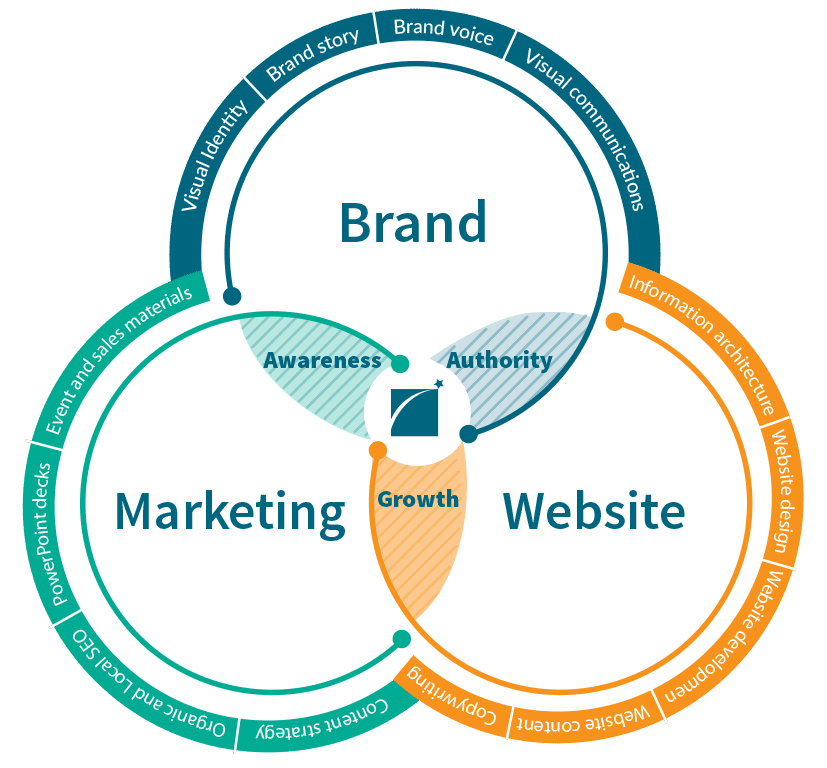Why your Life Sciences Brand Identity, Website and Digital Marketing Must Work in Harmony
Are you in the process of creating or commissioning a new website for your life sciences, biotech, or healthcare business?
If your website doesn’t match your life sciences brand or digital marketing, you have a problem.
Here we outline why your website, brand and digital marketing need to work in perfect harmony. Otherwise you could be wasting lots of money.
Increasing brand awareness and generating leads and sales is crucial in the highly competitive and fast-moving life sciences market. As the industry innovates and evolves, a standout online presence has become essential to attract investment, partners, and customers.
But where do you start?
Without an internal marketing department, some life sciences companies commission a new website only to be disappointed by the results.
A website alone is not enough for online success. Your brand identity, website, and digital marketing must work in perfect harmony to make a significant impact.
This article examines brand identity, website design, and digital marketing in greater detail and explains how they must work together to produce the results your business deserves.
Although described here individually in what appears to be a linear stepwise process, it’s very difficult to know where one ends and the other begins.
Thus, if you were to work with a life sciences branding and website design consultancy to develop a brand identity, website, and digital marketing strategy, you would find the process synergistic.

Brand Identity
Do your potential customers or clients already know you exist?
Could they pick you out in a crowd?
Does your story resonate with your audience?
A life sciences brand identity is the key to standing out from your competition, making yourself memorable, and creating emotional connections with your customers. It's the tool for sharing your story and values, going beyond your products and services to build trust and loyalty.
Establishing a strong brand identity is not a choice; it's a must.
However, it’s not unusual for even the most ambitious biotech or healthcare businesses to commission a new website or upgrade based solely on a current logo and a handful of preferred colours without first developing a brand strategy. If this sounds familiar, don’t worry; we’re here to help.
A brand identity combines visual elements, content and tone that give your brand a personality, including:
- the logo
- website design
- colour palette
- typography
- tone of voice
- slogans
- core messages
- imagery, etc.

To create a strong brand identity, you must delve into the world of your competitors, understand your desired audience, and define what your company stands for, including its mission, vision, and values. This deep understanding is the foundation for building a brand identity that reflects your business and connects with your audience.
Your brand identity should underpin all your marketing efforts, building consistency across all communication channels. Together with a brand strategy, it should align with the direction of your business plan.
Talk to us about your project.
Let’s work together to develop your brand identity and strategy.
Website Design
A website is your crucial online presence, a 24/7 window to your business that works hard to build brand awareness, engage with customers, and generate leads.
Thus, your website is more than a beautiful design and some words. Quite simply, your website is there to portray the best version of your company in the digital marketplace. It’s a crucial marketing tool that combines your brand identity and digital marketing efforts to drive your business forward.
Your company's mission, vision, and values must be reflected in its design, performance, and content, attracting and engaging your target audience, partners, or investors and differentiating you from your competitors.
A strong brand identity created from the very essence of what your business stands for will translate into a cohesive, stand-out website design that showcases your products and services, shares your values, engages with your audience, and builds authority in the life sciences marketplace.
But how do new customers find you online? A website alone is not enough. Digital marketing (more below) works with your brand identity and website to help prospective customers find you, improving reach and engagement and driving conversions.

Let us ensure your website design project meets your business goals.
Our proven process deep dives into your business to inform the development of distinctive branding and creative marketing solutions.
Digital Marketing
As mentioned above, a website must work hard to communicate your brand, build awareness, attract your target audience, and speak to their pain points and needs. It can’t do this without digital marketing, but what is digital marketing?
A common misconception is that digital marketing only refers to social media and paid advertising. However, as mentioned above, your website is also a digital marketing tool.
Life sciences digital marketing includes a wide range of online strategies and tactics aimed to promote a brand, product or service, including:
- Search engine optimisation (SEO)
- Content marketing, e.g. blog posts,
- Email marketing
- Social media marketing
- Paid advertising

These strategies and tactics must be flexible enough to adapt to changes in customer expectations and market trends but must be consistent in their core values. Consistency comes from your brand strategy and identity.
Digital marketing is most effective when built on an established perception of your company and brand identity. Without brand identity, digital marketing leads to inconsistent, generic marketing material that doesn’t reflect your company's personality.
This results in a confused target audience that will question your credibility. This is also true for other marketing materials, such as slide decks or event and sales materials.
So, how do you use digital marketing to get your website in front of the right audience?
Before using social media or paid advertising, it’s essential to integrate digital marketing techniques such as SEO and content marketing into your website design. These are the first steps and part of your long-term strategy to increase organic traffic, improve user experience (personalised and targeted messaging), increase search engine rankings, and improve conversion rates.
Websites that create regular original content in conjunction with SEO perform better than websites that don’t. SEO and content marketing also help build your brand presence and visibility online.
By optimising your website’s performance in this way, you can offer relevant, high-quality content that focuses on your audience’s intent before you start redirecting potential customers to it through email marketing, social media campaigns, and paid advertising. Thus, you can reduce bounce rates and increase your return on investment from paid campaigns.
As you can see, discussing brand identity, website creation, or digital marketing in isolation is impossible.
Mentioning one automatically refers to the importance of the other.
.

The Takeaway.
Don't waste time and money working on these things in isolation.
Brand identity, websites and digital marketing must work together for your life sciences business to succeed online.
For example, a strong brand identity is essential for designing a standout, high-performing website and planning a consistent, effective marketing strategy.
Similarly, your website must integrate digital marketing strategies to engage with your target audience, and your email marketing and paid advertising need a website or landing page to convert interested customers to sales.
Are you in the process of creating or commissioning a new website for your life sciences, biotech, or healthcare business?
Do you need more information about the essential relationship between life sciences branding, web design, and digital marketing?
Arttia Creative’s experienced brand and website consultants are here to help you.
Elevate your branding and digital marketing, save time and money.
Talk to us about how we can help you build a strong online presence that converts.

Belinda White | Creative Director